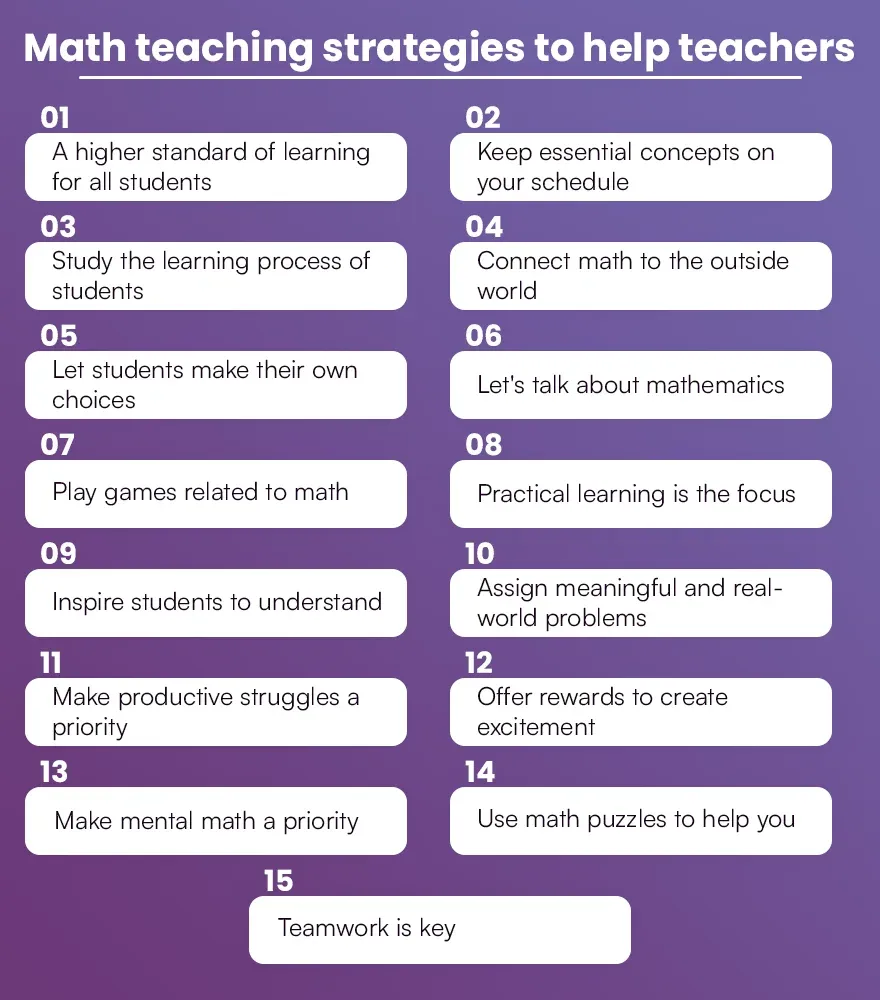AssignmentGPT Blogs
Friend or foe – maths is an inseparable part of life.
Love it or hate it, it either becomes your best friend or your worst nightmare. It is like that 1 friend that makes his way on every trip – even if no one likes him.
Math isn't just about numbers; it's about solving problems, reasoning and thinking outside the box. It is the priority for most teachers to combine the best of various methods to make math fun and easy for the students to understand. The right strategies make it possible to dismantle the obstacles, build confidence and arouse student interest in math. Whether it is a difficult calculus or a simple addition, several effective teaching strategies for math can outperform and thus provide success to a student.
Quick Summary
This blog will show 15 interesting maths teaching methods and make math real for them. The list of these techniques includes not only the explanatory instructions but also the captivating games that cause effective learning for every student.
General math teaching strategies to help teachers
Let’s go through the strategies that can make a big difference in the math classroom.

1. Set High Standards for All Students
Encourage all students to be ambitious. When students know, they are expected to do well, they often try harder to succeed. Setting clear goals helps students see that math is not just about getting the right answer; it is about developing their critical thinking skills and problem-solving abilities.
2. Keep Essential Concepts on Your Schedule
Focus on core concepts and skills that students need to build a strong foundation. Revisiting important ideas throughout the year to reinforce learning. This keeps essential skills fresh in students' minds and helps them retain their knowledge in the long term.
3. Study the Learning Process of Students
Understanding how your students learn best is key to effective teaching. Some of them could be visual learners, whereas others were hands-on. Tailoring teaching strategies for math to match different learning styles allows every student to grasp concepts in a way that resonates with them.
4. Connect Math to the Outside World
Math can be abstract. Nevertheless, if we show students their usefulness in the day-to-day world, it will be far more engaging. Math problems are related to real conditions in life, such as computing changes, measuring ingredients, or understanding what time is. When they understand that math is a part of their daily lives, they are more willing to learn.
5. Let Students Make Their Own Choices
The students will feel involved if they are given a sense of ownership, and thus, their engagement can be positively affected. Allow students to perform assignments by giving them a choice or letting them choose a problem with which they are confident. Students’ mastery abilities are now in their hands.
Also read this article : 16 of the Best AI Tools for Teachers in 2024
6. Let’s Talk About Mathematics
Encourage math talk in class. Let the students elaborate on their solution strategies and address others' problems. This not only reinforces their knowledge but also aids in developing communication skills. Students engage in math discussions, and they solve a problem by thinking deeply by which they find different methods to solve a problem.
7. Play Games Related to Math
Games make learning fun! Regardless of whether it is a board game, card or app, math games may be engaged creatively to learn them in a playful manner. Secondly, children are often inspired to work together and engaged in problem-solving. Thus, math becomes less alarming.
8. Practical Learning is the Focus
Hands-on activities, such as measuring objects or using manipulatives, make things that children cannot better understand. Engaging students in practical tasks brings math to life, helping them understand concepts by seeing and doing.
9. Inspire Students to Understand
Motivate students to see the potential careers and doors that math can open to them. Demonstrate the application of mathematics in engineering, art and technology. Inspired by possibilities, students are more willing to work through challenges.
10. Assign Meaningful and Real-World Problems
Assign problems related to students' lives, such as budgeting or project creation. Real-world applications make math relevant and help students understand their importance outside the classroom.
11. Make Productive Struggles a Priority
Learning math isn’t always easy, and that’s okay. Motivate students to persevere and work through the difficulties. Finding solutions on one's own without the guidance of a teacher can make them more resilient and increase their critical thinking skills.
12. Offer Rewards to Create Excitement
A small reward can go a long way to motivating students. It could be something like verbal praise, a sticker or extra credit. It brings about the recognition of their effort, which assesses how the student is engaged in their studies. The teacher oversees the process and serves as a judge of students’ input.
13. Make Mental Math a Priority
Practicing mental math boosts speed and confidence. Instant math can be very helpful for students in real-life situations and make them more fluent in math. Mental math exercises that are done regularly are a quick and efficient way to keep students sharp.
14. Use Math Puzzles to Help You
Puzzles stimulate the brain and make math fun. Crosswords, Sudoku, and logic puzzles require reasoning and problem-solving skills. Furthermore, puzzles motivate math students to think out of the box by drawing parallels between math and all other disciplines.
15. Teamwork is Key
Group work is a type of project students can learn from each other. Student collaboration has many benefits, one of them is solving complex problems and getting new perspectives. Sharing experience and the acquisition of social skills through teamwork, which is considered to be more interesting. This makes math a more meaningful situation.
How to Teach Math to Elementary Students in an Effective Manner
Teaching math to younger students requires patience and creativity. Here are a few effective teaching strategies for math teachers working with elementary students:

1. Unambiguous and Clear Instruction
Break down problems into simple steps. Clear instructions lower confusion and make it easier for students to follow the lesson. Charts and diagrams are visual aids that can be provided to the teacher for the improved interpretation of the subject.
2. Teaching in a Cooperative Manner
Younger learners find joy in group learning, where they cooperate with their classmates to find solutions. It enhances their social skills which they can learn from each other. Also, mathematical group exercises bring this one long path of math to a team.
3. The Use of Visualizations Visual aids are powerful tools for elementary math. They use pictures, blocks and interactive boards which enable students to see actual applications of math. Meditation makes abstract mysteries more tangible and able to be understood by children.
Conclusion
Incorporating these strategic teaching strategies for math helps teachers create an effective classroom. Math doesn’t have to be intimidating due to the usage of clear instructions, real-world applications and interactive activities. The students are actively involved, and they view math as easy and fun. Thus, it becomes a less feared subject among them.
AssignmentGPT AI can also be used as a tool to assist teachers through its resource mechanisms. They will be able to share with their students. Also, it helps the teacher to be more relaxed when his/her students are working hard to get good grades.
FAQs
1. What are some essential techniques of teaching mathematics?
2. How can I motivate my students to enjoy math?
3. Why is mental math important?
4. What’s the best way to use math puzzles in class?
Content writer at @AssignmentGPT
Kandarp’s world is powered by conversations, content, and creativity. With experience across branding, literature, publishing, and strategy, he has helped shape identities and stories for businesses across industries. At AssignmentGPT AI, he leads a team that blends sharp content, strong design, and local insight to turn businesses into brands that connect with people.
Master AI with
AssignmentGPT!
Get exclusive access to insider AI stories, tips and tricks. Sign up to the newsletter and be in the know!

Transform Your Studies with the Power of AssignmentGPT
Empower your academic pursuits with tools to enhance your learning speed and optimize your productivity, enabling you to excel in your studies with greater ease.
Start Your Free Trial ➤Start your success story with Assignment GPT! 🌟 Let's soar! 🚀
Step into the future of writing with our AI-powered platform. Start your free trial today and revolutionize your productivity, saving over 20 hours weekly.
Try For FREE ➤








